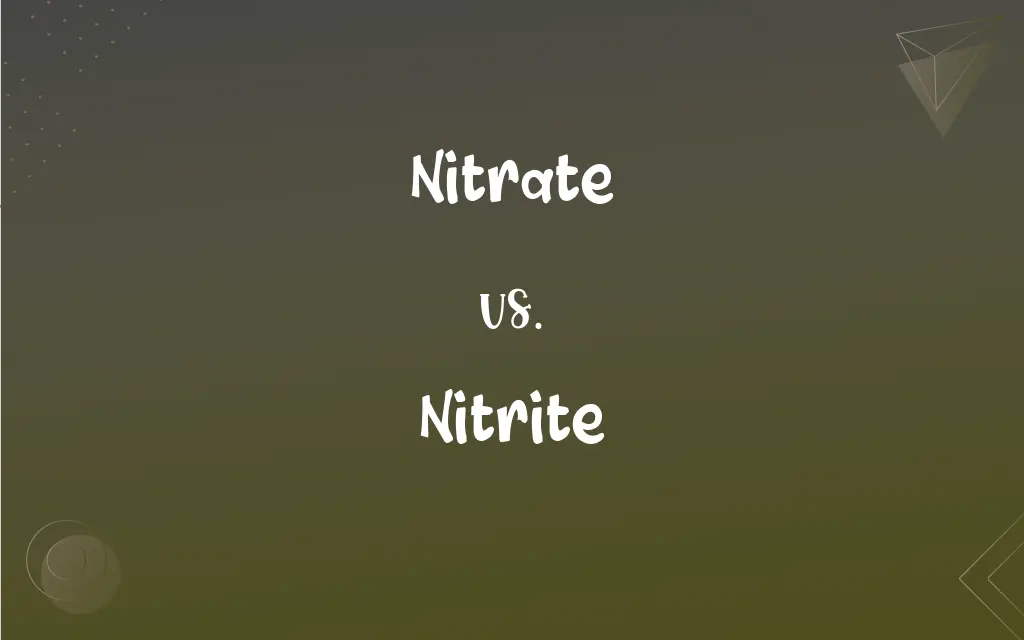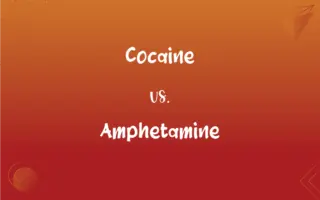Nitrate vs. Nitrite: What's the Difference?
Edited by Aimie Carlson || By Harlon Moss || Updated on June 26, 2024
Nitrate (NO3-) and nitrite (NO2-) are chemically related ions, with nitrate having three oxygen atoms, and nitrite, two; used in agriculture and food preservation, respectively.

Key Differences
Nitrate (NO₃⁻) is an anion consisting of one nitrogen atom bonded to three oxygen atoms. It is primarily found in fertilizers and soil, playing a crucial role in plant nutrition. Plants absorb nitrate from the soil and utilize it for growth and development. On the other hand, nitrite (NO₂⁻) consists of one nitrogen atom bonded to two oxygen atoms. Nitrite is often used as a preservative in processed meats to prevent bacterial growth and maintain color.
The conversion between nitrate and nitrite is a part of the nitrogen cycle. In the soil, nitrate can be reduced to nitrite by bacteria through a process called denitrification, which ultimately returns nitrogen to the atmosphere as nitrogen gas (N₂). Conversely, nitrite can be oxidized to nitrate, particularly in oxygen-rich environments, ensuring the continuation of the nitrogen cycle.
Nitrate is generally less toxic compared to nitrite. While nitrates are relatively stable and pose less immediate risk, nitrites are more reactive and can form harmful compounds like nitrosamines, especially in acidic conditions, such as those in the human stomach. This potential for harmful reactions makes monitoring nitrite levels in food and water crucial for health safety.
Both nitrate and nitrite are important in various environmental and industrial processes, but their impacts on health and the ecosystem differ significantly. Nitrate supports plant growth and agricultural productivity, while nitrite's primary use in food preservation must be carefully controlled to avoid adverse health effects.
Comparison Chart
Chemical Formula
NO3−
NO2−
ADVERTISEMENT
Oxidation State
Nitrogen is in the +5 oxidation state
Nitrogen is in the +3 oxidation state
Common Compounds
Potassium nitrate (KNO3)
Sodium nitrite (NaNO2)
Usage in Agriculture
Widely used as a fertilizer
Less commonly used as a fertilizer
Role in Human Body
Generally considered non-toxic
Can form harmful nitrosamines
Nitrate and Nitrite Definitions
Nitrate
Nitrates are salts or esters of nitric acid containing the anion NO3−.
Many vegetables are rich in nitrates, which can be beneficial for heart health.
ADVERTISEMENT
Nitrite
In food preservation, nitrites serve to inhibit the growth of bacteria.
Nitrite is frequently utilized in the preservation of various processed meats like sausages.
Nitrate
Nitrate, in agriculture, refers to a rich nutrient that enhances the growth of plants and crops.
Farmers often use nitrate fertilizers to boost crop yields.
Nitrite
Nitrites are salts of nitrous acid and contain the anion NO2−.
Sodium nitrite is commonly used to cure meats and give them a pink color.
Nitrate
In aquatics, nitrate is a compound that can accumulate and become harmful to fish.
Excessive nitrate levels in an aquarium can lead to the death of fish if not managed properly.
Nitrite
In an environmental context, nitrite can act as a nutrient in aquatic ecosystems.
Elevated nitrite levels in a pond can alter the ecosystem, often negatively impacting fish populations.
Nitrate
Nitrate film is a highly flammable film once utilized in the cinematic industry.
Old movies stored on nitrate film require special handling and storage due to its combustible nature.
Nitrite
Nitrite, in human health, is often associated with the formation of potentially harmful nitrosamines.
Continuous exposure to high levels of nitrite may pose health risks over time.
Nitrate
In the human body, nitrates can be converted into nitric oxide, which has several health benefits.
Consuming nitrate-rich foods like beetroot can enhance athletic performance.
Nitrite
In chemistry, nitrite can act as a reducing agent in various reactions.
Nitrite plays a crucial role in several synthetic chemical processes in the laboratory.
Nitrate
The univalent anionic group NO3, derived from nitric acid, or a compound containing this group.
Nitrite
The univalent anionic group NO2, derived from nitrous acid, or a compound containing this group.
Nitrate
Fertilizer consisting of sodium nitrate, potassium nitrate, or ammonium nitrate.
Nitrite
(chemistry) Any salt or ester of nitrous acid.
Nitrate
To treat with nitric acid or a nitrate, usually to change (an organic compound) into a nitrate.
Nitrite
(chemistry) The univalent radical -NO2, and the anion NO2-
Nitrite
A salt or ester of nitrous acid; a compound bearing the -NO2 radical.
Nitrite
The radical -NO2 or any compound containing it (such as a salt or ester of nitrous acid)
FAQs
Are nitrate and nitrite safe for human consumption?
In regulated amounts, nitrate and nitrite can be safe, though excessive intake can be harmful.
How does nitrate affect plant growth?
Nitrate is vital for plant growth, providing necessary nitrogen to build proteins and other molecules.
Can nitrate and nitrite be naturally occurring?
Yes, both nitrate and nitrite can be found naturally, especially in certain vegetables.
How are nitrate and nitrite measured in food and water?
Various methods, such as ion chromatography and colorimetric assays, are used to measure nitrate and nitrite.
Are nitrate salts and nitrite salts used in the same way?
No, nitrate salts might be used as fertilizers, while nitrite salts are often used in food preservation.
Are nitrate and nitrite only utilized in agriculture and food industries?
While prevalent in agriculture and food, they’re also used in other industries like pharmaceuticals and explosives.
What role does nitrite play in the nitrogen cycle?
Nitrite is an intermediate in the nitrogen cycle, being converted from ammonium and to nitrate by bacteria.
How are nitrate and nitrite commonly used in agriculture?
Nitrate is often used as a fertilizer, while nitrite is not commonly used in agriculture.
Is nitrate commonly found in drinking water?
Nitrate can be found in drinking water, often from agricultural runoff, and elevated levels can be harmful.
What role does nitrite play in the human body?
Nitrite can be converted to nitric oxide in the body, playing a role in various physiological processes.
What is the primary chemical difference between nitrate and nitrite?
Nitrate has three oxygen atoms (NO3-) while nitrite has two (NO2-).
Which of the two is primarily used in curing meats?
Nitrite is typically used in curing meats due to its ability to prevent bacterial growth.
Why is nitrite used in food preservation?
Nitrite inhibits the growth of harmful bacteria and imparts a pinkish color to cured meats.
Are nitrate and nitrite related to “nitrous oxide”?
Nitrous oxide (N2O) is different but can be formed through biological processes involving nitrate and nitrite.
Can nitrate and nitrite impact human health?
Yes, in excess and under certain conditions, they can impact health, potentially forming nitrosamines, which are carcinogenic.
Is it possible to remove nitrate from water?
Yes, technologies like ion exchange and reverse osmosis can effectively remove nitrate from water.
Can nitrate and nitrite be found in processed foods?
Yes, nitrite is commonly found in cured meats, and nitrate may be present due to its conversion from nitrite.
Is nitrite or nitrate responsible for the “smoked” flavor in meats?
Nitrite can contribute to a characteristic flavor in cured meats, but it's not responsible for a smoked flavor.
Are there regulations governing nitrate levels in water?
Yes, many countries have strict regulations governing permissible nitrate levels in drinking water.
How do nitrate and nitrite impact environmental health?
Nitrate in water bodies can cause eutrophication, while nitrite can convert to nitrate and have similar impacts.
About Author
Written by
Harlon MossHarlon is a seasoned quality moderator and accomplished content writer for Difference Wiki. An alumnus of the prestigious University of California, he earned his degree in Computer Science. Leveraging his academic background, Harlon brings a meticulous and informed perspective to his work, ensuring content accuracy and excellence.
Edited by
Aimie CarlsonAimie Carlson, holding a master's degree in English literature, is a fervent English language enthusiast. She lends her writing talents to Difference Wiki, a prominent website that specializes in comparisons, offering readers insightful analyses that both captivate and inform.































































